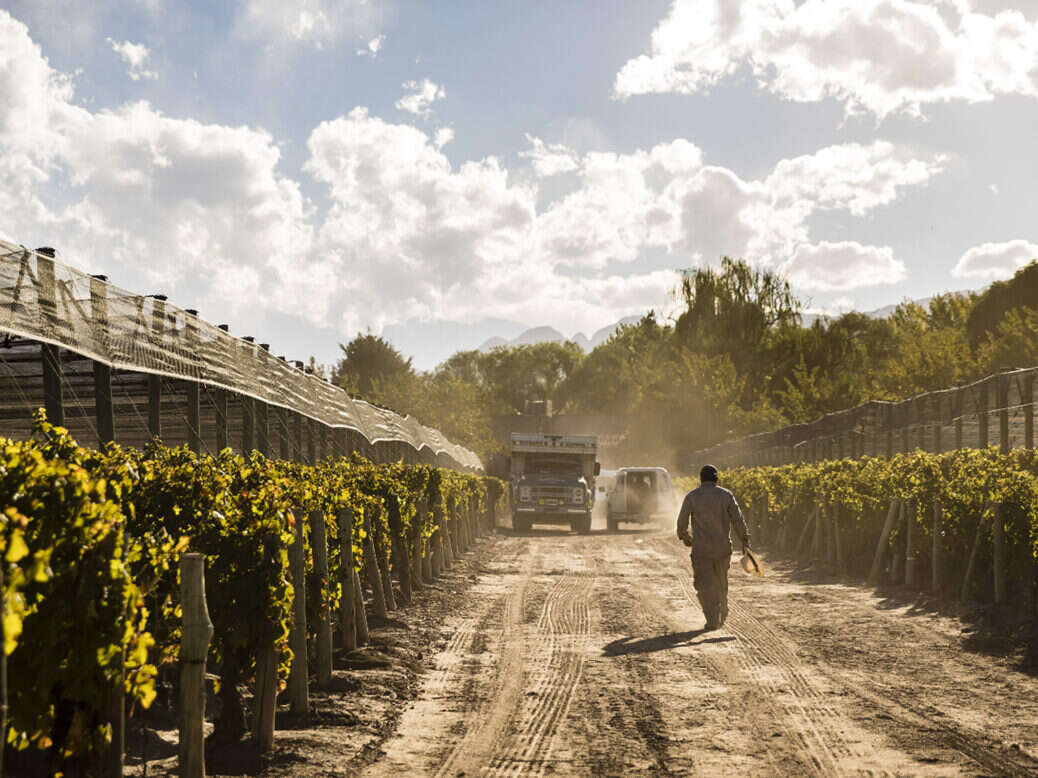
The price of Argentinian Malbec is rising fast, with rampant inflation only one part of a complex, multi-stranded story that has important consequences for lovers of country’s signature wine. Christiana Sciaudone reports.
The Argentinian economy is, for lack of a better word, a mess. The country’s financial situation is wreaking havoc on almost every aspect of the winemaking process, global supply-chain issues are contributing to bottle bottlenecks, and climate change is forcing growers to make costly adjustments to their vineyards—if they have the wherewithal. After all, it’s difficult to grow grapes in a desert.
Mendoza is Argentina’s primary winemaking region, an arid high plain where grapes grow in the shadow of the Andes Mountains. While they have been cultivated for drink for hundreds of years and, more recently, served local markets, it has only been in the past generation that Argentinian wine made it to the international table and, eventually, into the cellars of discerning collectors. For that, we have Nicolas Catena Zapata, above all, to thank (see also WFW 65, pp.162–69).
From 2000 to 2010, sales of Argentinian wines grew 30 percent annually. The growth rate has slowed, but interest in Argentinian wines has not, and they are becoming a staple for many collectors. Grape production in the country, however, peaked in 2013 at nearly 29 million quintals, and last year it slipped to 22 million quintals. But that’s only one reason why it’s about to get more expensive.
Grapes are a commodity
In a world of rising costs, everyone is looking to cut them wherever they can. For Argentinian winemakers, the easiest ingredient to squeeze is the one they already are: the grapes.
The fruit grows so well in Mendoza that the farmers there have almost no bargaining power. Wine producers buy grapes early in the season, setting a price they won’t actually pay for another several months, long after the harvest.
While costs go up—inflation in Argentina is raging at more than 60 percent and rising (more on this below)—they’re locked in at the rate they set months earlier.
“We harvest in March, and they pay six months later,” said Pepe Reginato, a longtime grape grower and winemaker who has put production on hold this year because of the various challenges being faced.
“Imagine with inflation—it’s practically suicide.” Reginato and his family have been making highly rated sparkling wines in Mendoza for three decades. He’s more worried for younger winemakers and for the future of the region than he is for himself.
Indeed, farmers are turning away from grapes and embracing higher-yielding agricultural crops that are more profitable, including walnuts and almonds. Since 2014, the area devoted to wine grapes has dropped annually.
Today, about 211,000ha (520,000 acres) are used to grow grapes. That’s projected to drop some 19 percent to 170,000ha (420,000 acres) in 2027, according to estimates from the National Institute of Vitiviniculture.
“Winemakers are actually happy to have to produce less but sell their wine at a higher price,” said Erwin Henriquez, a consultant at Euromonitor International who studies the sector. “It’s the law of offer and demand. You have less wine, so you can sell it for more on the international market.”
But for winemakers to do that, they have to be able to operate. And not much is operating smoothly in Argentina these days.
How the surreal Argentinian economy is hitting Malbec prices
Attempting to understand Argentina’s economy requires the willing suspension of disbelief. Even then, it is still likely to boggle the mind. The country is in a staggering amount of debt. It owes the International Monetary Fund more than $40 billion and has, effectively, almost no US dollars in international reserves. So, what does that actually mean?
The government has put the brakes on imports. Why? When you import something into Argentina, you have to pay in US dollars. The government is desperate to hang onto whatever dollars it has in the country and is now prohibiting the use of those dollars to pay outsiders.
While some wineries in Argentina are able to make do with the local production of bottles, labels, and so on, others must import them, since there’s been little investment over the years to supply the market (on top of a general global bottle shortage).
Throwing a wrench into the works over the past year was a fire at one of the three local bottlers. Gabriel Rezzan, managing director of Bodegas Krontiras, which makes organic, biodynamic, and vegan wine in Lujan de Cuyo in Mendoza, said the lead time for buying bottles used to be short—one month in advance at most.
Now, they are planning one year in advance and have had to scramble to fulfill orders. In fact, Krontiras is among a group of small and medium-size wineries that negotiate among themselves to exchange bottles depending on timing and needs, like an unexpected order.
Rezzan has to import more than most because his winery is certified organic. That means, for example, bottles must be lighter than usual and corks must be properly sourced—requirements that cannot readily be met locally. Krontiras is able to survive thanks to a separate shipping business that’s helping it through the tight times. It might otherwise be unable to operate.
“There is no doubt that the situation is very critical,” said Mariana Onofri of Onofri Wines, a small-scale winery in Mendoza.
“The supplies—bottles, corks, labels, everything—are imported, so our cost is extremely high, and inflation is crazy. We lose the possibility of being competitive when presenting prices to importers.”
Different exchange rates
Beyond the limitations of the currency is the reality that there are now, in fact, several exchange rates in the country. The two best known are the official rate, currently around 136 pesos per US dollar, and the “blue” rate, at about 288 pesos per US dollar.
The latter is up from 200 pesos at the start of the year, thanks to economic jitters and, more recently, a rotation of people through the ministry of economy struggling to put in place measures to keep the country afloat.
How does this affect wine producers? If they export, they would seem to be in a strong position, in that they have US currency coming in. As noted above, however, the banks in Argentina take those dollars in and pay out at the official rate.
So, for example, if a producer makes $100 in sales, it will receive about 13,665 pesos. That’s not so bad, but the producer’s costs are not in official dollars. So, if it imports $100 worth of bottles, then it has to pay at the blue rate, which totals 28,800 pesos. It’s easy to see how earnings and spending may never align.
“I basically have an 80 percent tax from the government, because I first have the 60 percent tax of giving me the bad dollar, and then I pay corporate taxes of 37 percent—so it’s a tragedy,” said Laura Catena, Nicolas Catena’s daughter and managing director of Bodega Catena Zapata.
This assumes, of course, that the government continues to allow companies to send dollars abroad to make any kinds of payments there. If it blocks those, it could be devastating for Catena Zapata.
The company has nine employees abroad, all highly trained specialists whose sole responsibility is to sell Catena Zapata’s wines.
“If [the government] says we can’t pay people outside Argentina, I lose all those employees,” Catena said. “It takes a long time to train a person to sell fine wine.”
The situation is also depriving her of any competitive advantage. “If my dollar was coming in at the real rate, my salary bill would be lower than in other parts of the world, but right now I’m paying super-high salaries in dollars.”
Everyone’s margins are getting squeezed, and many wineries are juggling and negotiating to stay alive.
“This is a financial game, trying to win time. We have to be creative in terms of how we sustain the winery until we get stable again,” Rezzan said. Nobody knows what will happen, but everybody is sure something’s got to give—it always does.
In the meantime, Reginato is putting his production on hold for the first time, because of a shortage of fuel—again, because the country isn’t permitted to pay for imports. His normal sugar supplier has shut down operations until he can get fuel to power the plant. “The uncertainty is maddening,” Reginato said. “We don’t know what to do.”
Climate change in the desert
Argentina is not immune to climate change, either. Mendoza has been a desert as long as people have been growing grapes in the region, which has depended on water from the snow-capped Andes.
But recent data show not only that temperatures have been rising but that rainfall and snowfall have been reducing. Since 2007, every year has had less rainfall than the 30-year average for 1980–2010, according to Meteoblue, a website that delivers highly localized weather information around the world.
“We are not prepared for this challenge,” said Hervé Birnie-Scott, estate director at Terrazas de Los Andes, owned by luxury conglomerate LVMH.
“There is no national and provincial policy to address these issues and invest.”
He suggests that drip-irrigation, as implemented by Terrazas de Los Andes and Catena Zapata, could cut water use in vineyards by “as much as 50 percent.”
But most smaller producers lack the financial resources to install such systems, which cost about $3,500 per hectare (2.47 acres). Because most vineyards lack water, yields are falling, and plants and producers are suffering.
The fittest may survive and thrive
Catena Zapata could have tripled sales last year if it had had the stock, Catena said.
“A lot of specialists who sell to collectors are now selling them Argentinian wine, which they weren’t before. So, I am very positive about sales. Part of it is due to millennials. They grew up on Malbec. They’re now the people with the buying power. They like Malbec, they know Malbec, they demand it.”
Those who won’t benefit are all the smaller producers with less pricing power. Already-tight margins may not allow them to survive these tough times.
Although LVMH is a massive company, it is also answerable to shareholders. But Birnie-Scott says that the company is committed to the region and its people, especially when the quality of the wine is ever higher. “We are going away from the generic production of Malbec,” Birnie-Scott said. “Even if in the short term we have some difficulties, we are here for the potential of the place and the terroir.”
Malbec will, of course, continue to be cultivated, but the best wines from Mendoza, specifically from the Uco Valley, will command higher prices, Birnie-Scott said. “Because of the scarcity of the water, everything that we grow and produce in terms of wine has to have quality and added value.”
“Mendoza is still a huge opportunity,” Catena said, “until our wines are priced at the same level as those from France. All my life, every time there’s been a very bad moment, it’s got fixed. So this is another reason I’m hopeful. I feel like sometimes you need a crisis. Something good has to come from it.”
When that might be, however, remains to be seen. More than $1 billion in dollar deposits has been withdrawn since the first economy minister resigned in early July, Bloomberg reported. And deposits provide the pulse of Argentinians’ economic expectations. During the crisis of 2001, the government banned large ATM withdrawals. Argentinians are clearly not expecting good news in the short term, even if wine lovers elsewhere may see ever-finer—and ever-pricier—Malbec.






